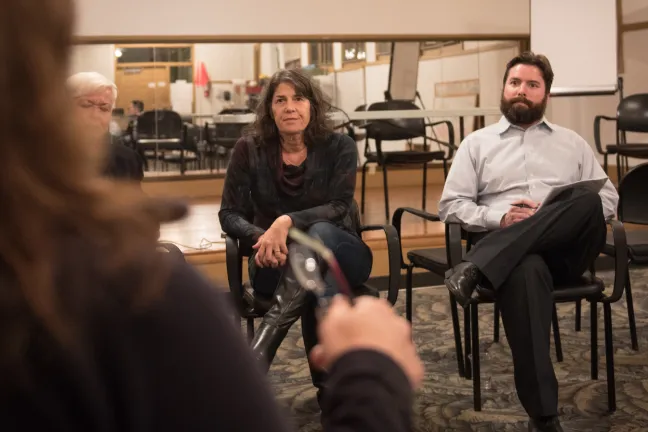Multnomah County Public Health officials joined Commissioner Dr. Sharon Meieran Thursday night at a community meeting in Linnton to discuss a proposal to limit wood burning on winter’s worst air quality days.
The following is a Q and A based on the concerns of residents who live on forested properties along Old Germantown Road and met Nov. 16 with County officials in Linnton.
Won’t this harm people who need wood stoves for heat during cold months?
The ordinance would exempt anyone using wood as their sole source of heat or who needs to burn wood because their furnace is broken. Anyone who is low-income would be exempt, as well as anyone using an Environmental Protection Agency (EPA)-approved wood pellet stove. Enforcement would be complaint-driven. A large part of the program is educational. The first and second violation would trigger a certified mailing with educational materials about clean burning and pollution. Fines would not begin until at least the third violation.
“That’s a legitimate worry that we tried to address,” said Commissioner Meieran, who represents residents above Forest Park. “We’re not trying to take peoples’ wood stoves away.”
Inversions can last for a long time, so aren’t we really talking about burn bans that could last days?
“An inversion is one condition that might perpetuate a curtailment, but it’s not the sole,” said Matt Hoffman, who coordinates air pollution policy for the Health Department. “An inversion can trap pollution close to the ground, but the burning curtailments would also be determined by temperatures, wind speed and precipitation. Rain acts as a filter.”
Hoffman said the curtailment days would be rare. “For example, the last two winters, we wouldn’t have called a single curtailment day,” he said.
I support clean air, but an ordinance is just one more restriction. Why not try an advisory instead?
Multnomah County has issued burning advisories for more than a year, but there’s no evidence residents are volunteering to comply, Hoffman said. And there’s an urgency to keep pollutants below a certain level.
Following the Clean Air Act, the EPA began regulating six air pollutants including lead, ozone and particulate matter. The chemicals that contribute to particulate matter are often emitted from wood smoke, power plants, industry and automobiles. In recent years the county has come close to exceeding its federal cap on particulate matter 2.5.
Meieran said she and her colleagues on the Board are trying to strike a balance that protects people with health risks, and protects the environment while avoiding federal interventions that might limit development.
“If you get to the point where you exceed the federal guidelines, the federal government comes in and puts curtailments and rules that are more restrictive than what we’re doing,” she said. “We want something that is effective and really easy on people, but addresses health risks because smoke is actually really dangerous for people,
Why not focus restrictions on industry and vehicle emissions? Those cause more pollution than wood burning.
Health officials say that industrial emissions account for less than one percent of the county’s overall excess cancer risk from air pollution. Wood smoke, on the other hand, accounts for 20 percent, on par with emissions from cars and commercial trucks. When analysts compare those proportions during winter months, wood smoke becomes the single greatest polluter of particulate matter 2.5.
Do any other governments in Oregon have this type of restriction?
Similar ordinances are in place all across Oregon, including rural Washington County, Hillsboro, Eugene, Klamath Falls, Oakridge, Lakeview, Medford, Pendleton and Grants Pass. Prineville is drafting an ordinance, and Burns and La Grande have voluntary curtailment programs.
How can the public comment on this proposal?
People are encouraged to attend an upcoming community meeting December 7, 9:30 – 11 a.m. at the Multnomah Building, 501 S.E. Hawthorne Blvd., in Portland

